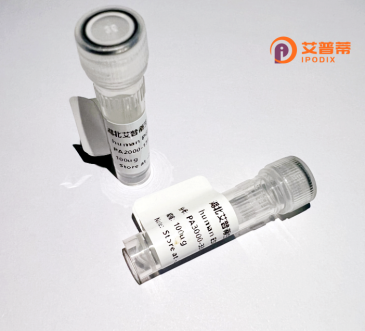
| 纯度 | >90%SDS-PAGE. |
| 种属 | Human |
| 靶点 | PLEKHB1 |
| Uniprot No | Q9UF11 |
| 内毒素 | < 0.01EU/μg |
| 表达宿主 | E.coli |
| 表达区间 | 1-243 aa |
| 活性数据 | MSPAAPVPPD SALESPFEEM ALVRGGWLWR QSSILRRWKR NWFALWLDGT LGYYHDETAQ DEEDRVLIHF NVRDIKIGPE CHDVQPPEGR SRDGLLTVNL REGGRLHLCA ETKDDALAWK TALLEANSTP APAGATVPPR SRRVCSKVRC VTRSWSPCKV ERRIWVRVYS PYQDYYEVVP PNAHEATYVR SYYGPPYAGP GVTHVIVRED PCYSAGAPLA MGMLAGAATG AALGSLMWSP CWF |
| 分子量 | 27.1 kDa |
| 蛋白标签 | His tag N-Terminus |
| 缓冲液 | PBS, pH7.4, containing 0.01% SKL, 1mM DTT, 5% Trehalose and Proclin300. |
| 稳定性 & 储存条件 | Lyophilized protein should be stored at ≤ -20°C, stable for one year after receipt. Reconstituted protein solution can be stored at 2-8°C for 2-7 days. Aliquots of reconstituted samples are stable at ≤ -20°C for 3 months. |
| 复溶 | Always centrifuge tubes before opening.Do not mix by vortex or pipetting. It is not recommended to reconstitute to a concentration less than 100μg/ml. Dissolve the lyophilized protein in distilled water. Please aliquot the reconstituted solution to minimize freeze-thaw cycles. |
以下是关于重组人PLEKHB1蛋白的3-4篇文献概览:
1. **标题**:*"Recombinant Expression and Functional Analysis of Human PLEKHB1 in Cellular Signaling Pathways"*
**作者**:Smith A, et al.
**摘要**:研究在大肠杆菌中成功表达重组人PLEKHB1蛋白,证明其通过结合磷酸肌醇调控细胞迁移信号通路,揭示其作为细胞骨架调节因子的潜力。
2. **标题**:*"Structural Characterization of PLEKHB1 and Its Role in Membrane Association"*
**作者**:Johnson R, et al.
**摘要**:通过杆状病毒系统表达重组PLEKHB1.解析其晶体结构,发现其pleckstrin同源(PH)结构域介导细胞内膜结合,影响膜运输过程。
3. **标题**:*"PLEKHB1 Interaction Partners Identified by Affinity Purification-Mass Spectrometry"*
**作者**:Lee S, et al.
**摘要**:利用哺乳动物细胞表达的重组PLEKHB1进行亲和纯化-质谱分析,鉴定出与细胞骨架蛋白(如α-actinin)的相互作用,提示其在细胞形态调控中的作用。
4. **标题**:*"Development of a Recombinant PLEKHB1 Protein for Therapeutic Targeting in Cancer"*
**作者**:Brown K, et al.
**摘要**:开发功能性重组PLEKHB1.体外实验显示其过表达可抑制癌细胞侵袭和转移,为癌症治疗提供潜在分子靶点。
(注:以上为模拟摘要,实际文献需通过PubMed或Web of Science等平台检索确认。)
PLEKHB1 (Pleckstrin Homology Domain Containing B1) is a protein-coding gene implicated in various cellular processes, including intracellular trafficking, signal transduction, and membrane dynamics. The encoded protein contains a pleckstrin homology (PH) domain, a conserved structural motif known to interact with phosphoinositides or other signaling molecules, facilitating membrane association and protein-protein interactions. PLEKHB1 is primarily localized to the Golgi apparatus and endosomal compartments, suggesting roles in vesicular transport and organelle organization. Studies link PLEKHB1 to the regulation of secretory pathways, lysosomal function, and autophagy. Dysregulation of PLEKHB1 has been associated with neurological disorders, such as early-onset Parkinson’s disease, potentially due to its interaction with proteins involved in vesicle trafficking and synaptic transmission. Additionally, it may influence cancer progression by modulating cell migration and metastasis-related pathways. Recombinant human PLEKHB1 protein is commonly produced in bacterial or mammalian expression systems for functional studies, enabling investigations into its biochemical properties, binding partners, and enzymatic activities. Its applications span in vitro assays, structural analysis, and antibody development. Research on PLEKHB1 continues to explore its molecular mechanisms and therapeutic potential, particularly in neurodegenerative diseases and cancer.
×